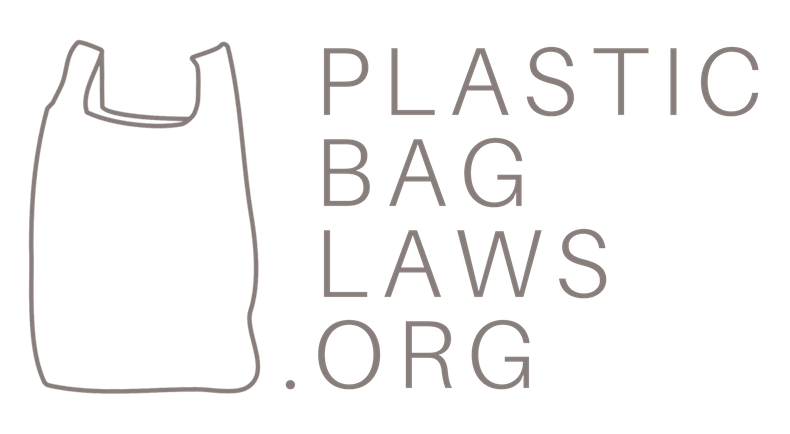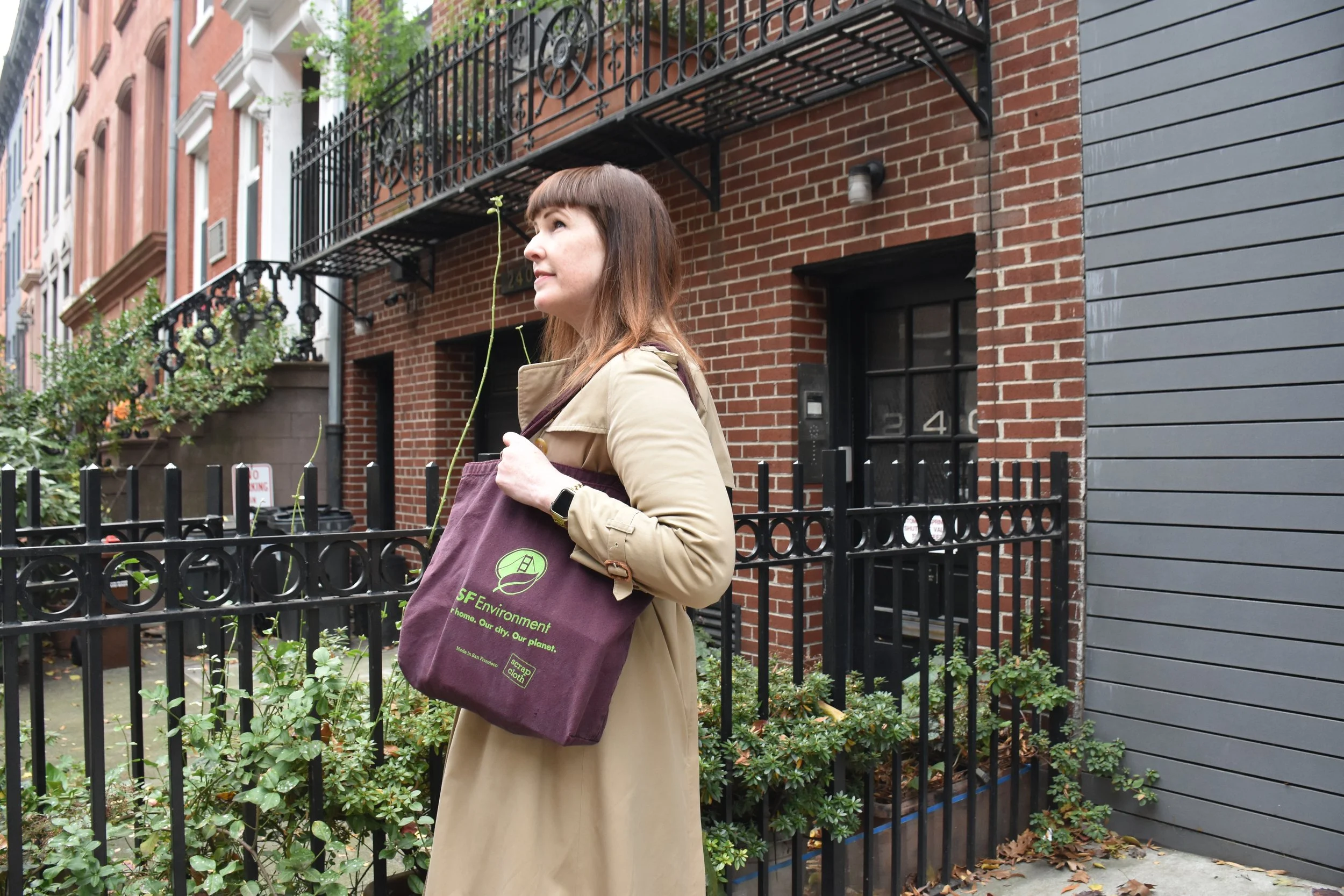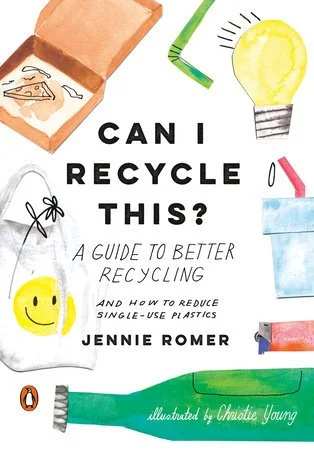Reintroducing PlasticBagLaws.org
Jennie Romer in New York City, holding one of the reusable bags San Francisco handed out when its amended bag law passed—a law she worked to strengthen by helping define “reusable” and adding a small fee to make the law more effective.
After nearly four years of abeyance, I’m excited to re-engage with PlasticBagLaws.org. When I launched the site in 2010, it was the only centralized resource tracking U.S. plastic bag ordinances. Since then, the landscape has expanded dramatically: nearly every state has debated bag policies, and well over 500 local ordinances have passed, with statewide laws now covering large portions of the population. It’s also been heartening to see confirmation that these efforts work—a report released last year found that well-designed single-use plastic bag bans have successfully reduced plastic bag use and the litter and pollution that come with it.
My fascination with plastic bag policy began in law school in San Francisco, where I had a front-row seat to the passage of the first bag ordinance in the country. While still a law student, I volunteered with the San Francisco Board of Supervisors office that introduced the law, helping to revise the ordinance language and develop supporting materials. Around the same time, while working at a law firm, I began calling city legislators and planners in other parts of the state on my lunch breaks to help them build their own administrative records for similar laws because plastics industry groups had started filing lawsuits. Somewhere along the way, I set out to deeply understand—and help shape—plastic bag policy nationwide, and that goal steadily took root. Over the years that followed, I wrote a few law journal articles on plastic bag policy and ultimately a book.
Eventually, I moved to New York City—to take on the biggest city in the country, one whose sentiments about plastic bags were very different from California’s.
In New York, where I arrived in 2012 to advocate for a local bag fee, behavior has changed visibly. Walk into a grocery store today and you’ll see more customers carrying reusable bags—or declining a bag altogether—than ever before and trees are often laden with far fewer errant plastic bags. That transformation started with local lawmakers who were willing to take a chance. NYC Council Members Brad Lander and Margaret Chin, the original co-sponsors of New York City’s plastic bag bill, were among the first city leaders I met after moving here. Brad immediately saw the importance of the issue and became a key ally.
Working together, I helped build a coalition of environmental organizations, local leaders, and community advocates to support the campaign. That grassroots effort—and the public debate it sparked—was later profiled in The New Yorker, which captured both the challenge and excitement of trying to pass a law that would change something as small, and yet as ubiquitous, as a shopping bag.
When our local bill finally passed, it felt like a breakthrough for everyone involved. But within weeks, the state legislature began moving to overturn it. Brad and I drove up to Albany together to try to reason with legislators. It didn’t work, but I’ll never forget his mix of passion and political savvy in that moment. That experience underscored how much persistence—and sometimes heartbreak—comes with local environmental policy work.
Today, New York State has a bag law that’s effective in many ways but not perfect. It was written as part of a budget deal, not through the years-long collaborative process that informed earlier drafts. It missed a few key points, like a more nuanced definition of “reusable bag,” that could make it stronger and more aligned with the intent of the original advocates. Across the country, newer statewide bag laws are taking those lessons to heart—drawing from the first generation of local and state policies to close loopholes, clarify definitions, and expand coverage. We’re now seeing a more consistent, data-driven approach to reducing plastic bag waste that builds directly on the groundwork laid over the past decade.
A plastic bag in a NYC tree—a reminder that progress is visible, but uneven.
From Grassroots Advocacy to Federal Policy
Before serving in government, I helped build a national network of advocates and local policymakers as a consultant and through my work at the Surfrider Foundation, where I helped relaunch a Plastic Bag Law Toolkit and later developed a Reusable Bag Ordinance Addendum. Those resources became go-to guides for cities and states looking to write strong, legally sound ordinances. In developing them, I made a point of working directly with bag manufacturers and recyclers to ensure that definitions and standards reflected real-world materials and operational realities. As newer statewide bag laws began to be developed, they relied upon the toolkits and learning and building off the previous laws.
At Surfrider I also helped launch a national map of plastic pollution policies—tracking not just bag bans but also foam, straw, and other local and state initiatives. The project revealed how one visible issue like plastic bags could catalyze broader systemic change and lead to more comprehensive approaches such as Extended Producer Responsibility (EPR) laws, which shift waste-management costs from taxpayers to producers and incentivize shifts in design toward a circular economy (and ideally financing reuse and refill systems). Businesses have begun responding to that shift—reducing the amount of plastic they use, redesigning packaging, and exploring alternative materials in anticipation of these new requirements.
After years of advocacy, I channeled that experience into writing Can I Recycle This? A Guide to Better Recycling and How to Reduce Single-Use Plastics, published by Penguin and illustrated by Christie Young. The book explores the journey of everyday items through recycling systems and offers practical advice for reducing single-use plastics. It was designed to make recycling and reuse approachable—combining humor, visuals, and policy insight to help readers understand not only what to recycle but why these systems work (or don’t).
In 2021, I was appointed to serve in the U.S. Environmental Protection Agency as Deputy Assistant Administrator for Pollution Prevention. Accepting the role meant pausing PlasticBagLaws.org and leaving my position at the Surfrider Foundation—a decision I made with a keen sense of the magnitude of how much I’d be learning as a deputy in the Office of Chemical Safety and Pollution Prevention.
As a political appointee at the EPA, I worked alongside colleagues—career and appointed alike—who brought deep expertise and a shared commitment to public service. I oversaw the Pollution Prevention (P2) grants program, Safer Choice, the Environmentally Preferable Purchasing (EPP) program, and supported new initiatives including advancing low-embodied-carbon construction materials. It was demanding work—layered, technical, and often slow—but deeply rewarding to help move the levers of government.
This immersion significantly enhanced my appreciation for the scope of responsibility that comes with public service—and of how difficult, but essential, it is to make progress within the machinery of government. That experience occasionally intersected with my earlier plastics work—drafting EPA’s comment letter to the FTC on the Green Guides and representing the agency during the global plastics negotiations.
Global Negotiations on Plastic Pollution
Last year, I served on the U.S. government delegation to INC-5—the fifth, and what was anticipated to be the final meeting of the UN’s Intergovernmental Negotiating Committee on Plastic Pollution—held in South Korea. In the lead-up, I joined interagency meetings at the White House complex to help shape the U.S. approach heading into the negotiations.
Sitting in a UN hall surrounded by delegates from every sector—governments, NGOs, businesses, community leaders—all discussing plastics as a global issue was profoundly moving. Fifteen years earlier, I’d spent endless hours testifying at city council hearings, still explaining why plastic pollution was a problem. Back then, much of the work was simply about raising awareness.
INC-5 cemented for me how fundamentally the landscape had changed. No one was really debating whether plastic pollution was a problem anymore; the question was how to fix it. Hearing countries from all over the world speak about production, waste, reuse, and circular systems was a powerful reminder of how far the conversation has come—and how many people are now working toward solutions. The discussions also reflected a growing recognition that plastic pollution is not only an environmental issue but also a humanitarian one, disproportionately affecting vulnerable communities.
Although the INC-5 meeting did not ultimately reach an agreement, it marked a major step forward in elevating plastics to the global policy agenda and in my own sense of how systems change truly unfolds. By the INC-5.2 intersessional meeting, the divisions among countries had widened and the path forward remained uncertain—but the global momentum continues.
The Next Chapter
As we enter the next phase of this movement, PlasticBagLaws.org will remain online and serve as a historical record and educational resource. The site remains a snapshot of a pivotal moment in U.S. environmental policy—when cities led, and states began to follow.
I’ve recently taken a new role at the Ellen MacArthur Foundation, where I’m the Director of Policy, North America. My portfolio at the Foundation does not include plastics, but rather focuses on e-scrap and fashion circularity, two timely and emerging areas of the circular economy. I’m glad to be part of such a visionary organization for a circular economy, and my through-line remains the same—designing systems that prevent waste in the first place.
While my professional focus has broadened, I’m still keeping an eye on how plastic bag laws evolve. Every so often, I’ll pause outside a grocery store—in New York or one of the many other cities where I worked on the bag law—and watch people walk out with their own reusable bags, knowing I played a small part in that shift. I also enjoy sharing insights from Can I Recycle This? at events—continuing the conversation about how our recycling systems and commodities markets work, and how common-sense decisions and smarter frameworks can drive meaningful change.
— Jennie Romer
Jennie Romer’s book: Can I Recycle This? (Penguin, 2021).



